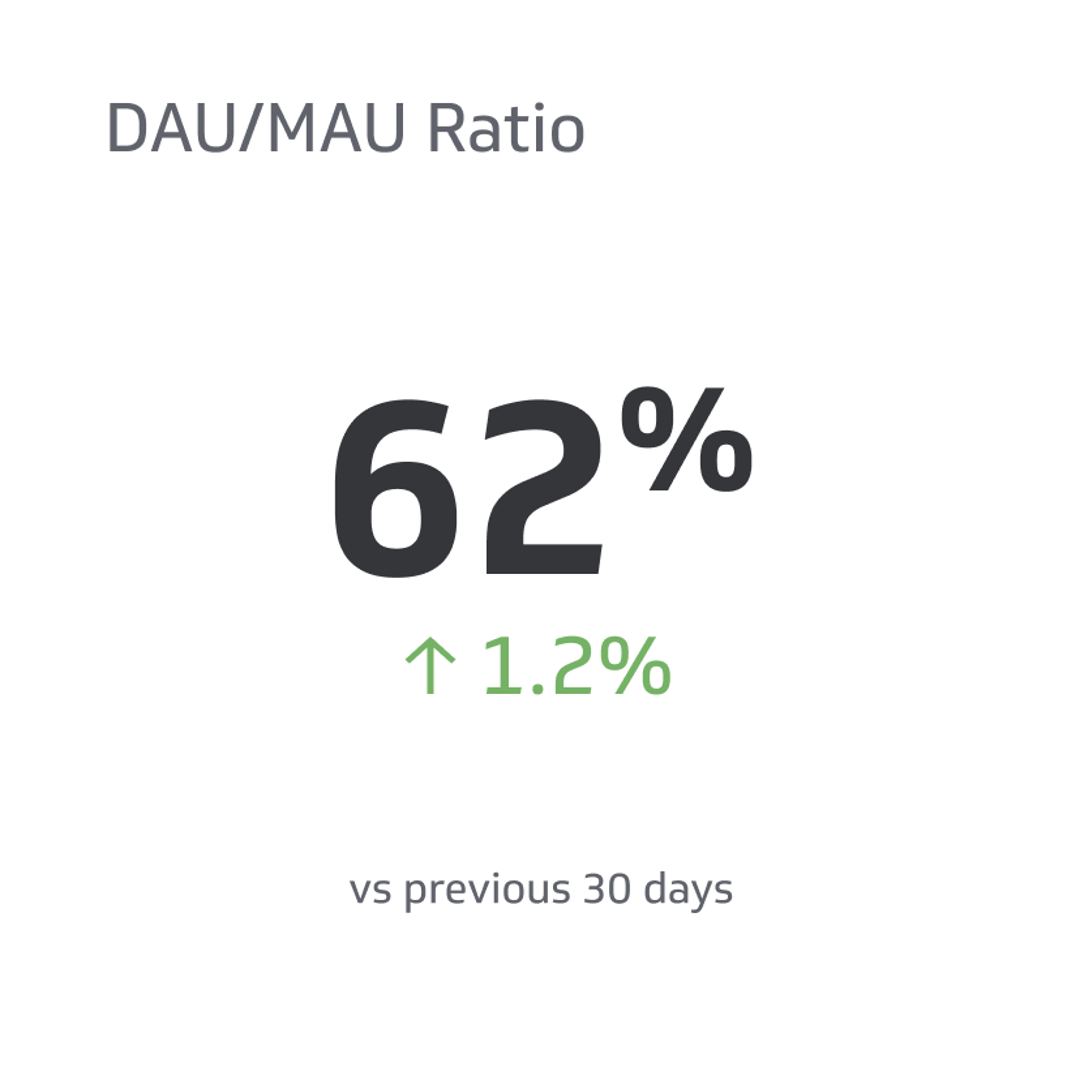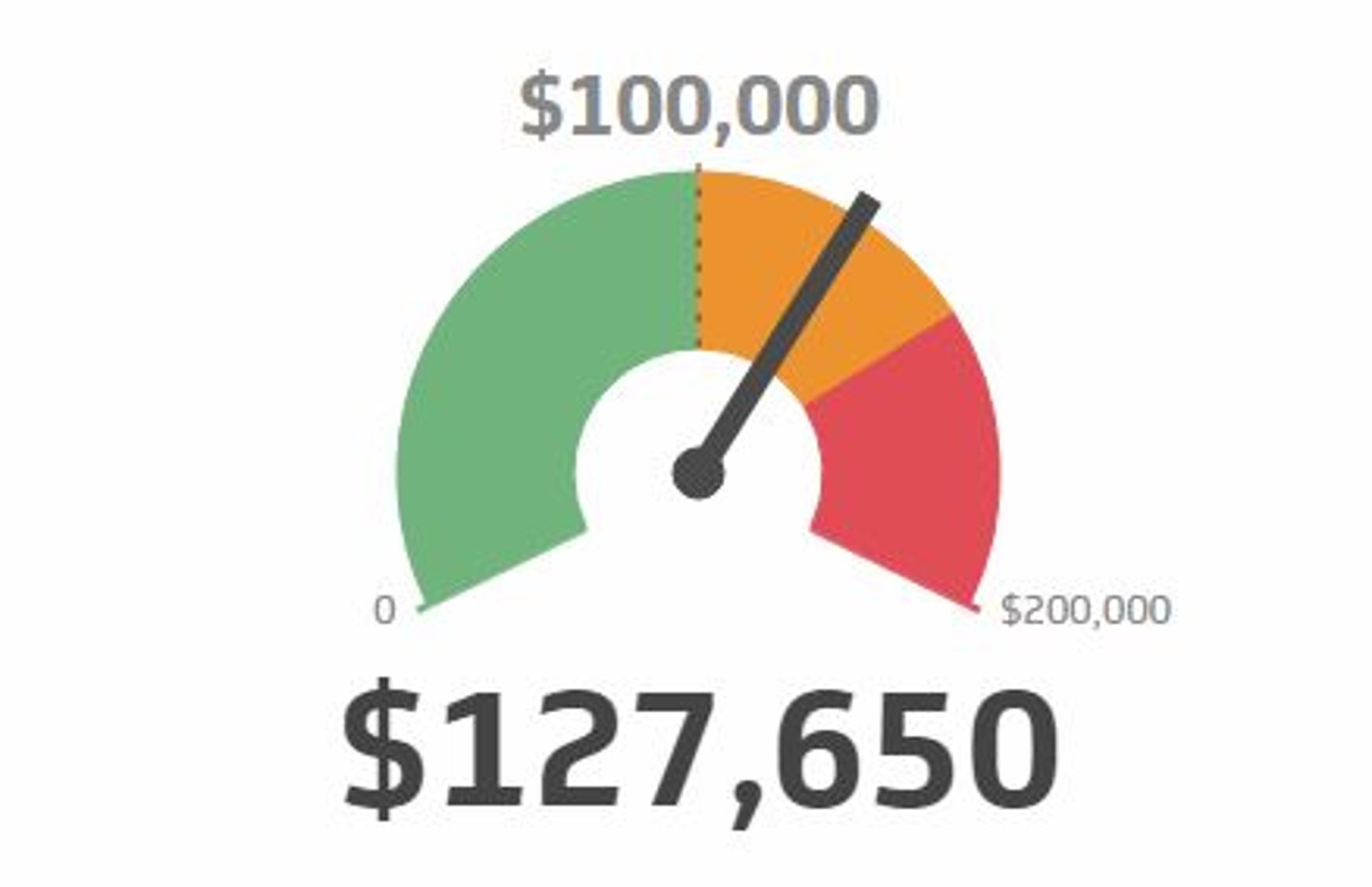DAU/MAU Ratio
Track all your SaaS KPIs in one place
Sign up for free and start making decisions for your business with confidence.

As a business owner, you need key performance indicators (KPIs) and metrics to know how well your company is performing. This data helps you learn about your business and makes adjustments to ensure your goals are met.
One valuable metric is the DAU/MAU ratio, which measures user engagement on a daily and monthly basis. If you're looking to leverage the ratio, continue reading as we explain what it is, how it could benefit you, and what you need to do to calculate it.
What Is the DAU/MAU Ratio?
Before understanding the DAU/MAU ratio, you need to consider the definitions of each acronym.
DAU refers to the daily active users of your game, app, or program. It details how many people visit and interact with one of those platforms every 24 hours. Most companies base DAU on the average each day of the month, but they can also view daily users.
MAU stands for your monthly active users. It follows the same concept, except it keeps track of all your visitors during a month and lets you know the total. You can monitor this data throughout the month (or longer) to identify growth patterns.
With that in mind, DAU/MAU refers to how many daily active users you have compared to your monthly users. The ratio helps you know the percentage of DAUs that use your app, game, or program.
What Counts as an Active User?
You may question what counts as an active user, so you should understand that it varies based on the system. For example, some businesses count anyone who logs in as a DAU/MAU, so they have higher numbers than other systems.
On the other hand, an online game may count a DAU/MAU as someone who plays a match daily or monthly. Another may define it as someone who uses the app for a certain length, such as five minutes or longer.
This depends on how you calculate your active users, so you can use that information to understand your business and customers. If you use an automated tool, you can select the method or use the preset one to calculate the ratio automatically.
Calculating the DAU/MAU Ratio
As you look into calculating the DAU/MAU ratio, it's pretty straightforward.
- Divide the DAU by the MAU
- For percentages, multiply by 100
For example, you may have 1,000 DAUs and 2,000 MAUs, meaning you must divide 1,000 by 2,000, giving you a 0.5 as your DAU/MAU ratio.
By multiplying the ratio by 100, you will find out that 50 percent of your customers use the program daily. You can then track this information over multiple months to better understand your customers and your business's performance.
What a DAU/MAU Ratio Teaches You
Sure, you may collect the data and understand the numbers, but what does that teach your company? As you keep track of your DAU/MAU, you can gain greater insight into your company and customers. Some of them include;
- Learn about your new users
- Check your retention rate
- If customers value your product
First, checking the MAU lets you see how many new users you get. Second, MAU shows you how many people used your app. If you have more MAUs compared to the previous month, you know you gained more users, or you may have lost and gained a few if it's around the same.
You can also see your retention rate by comparing how many DAUs you have to MAUs. The higher the stickiness - i.e., returning users - of your product, the more opportunities you have to monetize. In that context, a DAU/MAU ratio that is higher than 50% indicates that you have a user base engaging with your product for at least 15 days over a 30-day month.
Its effectiveness as a snapshot of user retention depends on the context of your product. For example, if you're monitoring engagement with a social media game, you'd expect a higher ratio, given daily play is often encouraged. Conversely, a travel app might not see a high DAU/MAU ratio, given vacations do not happen with enough frequency to merit sustained engagement.
The Benefits of DAU/MAU
Ensure you review and understand the benefits associated with DAU/MAU to see why it matters and how it can make a difference. Doing so will help you understand why companies use DAU/MAU as a metric even though it doesn't directly involve money.
Check for Progress
If you track your DAU/MAU ratio, you can see how your product or service progresses. Doing so means keeping track of the monthly ratio alongside the other numbers to see how they change between the months.
Some go the extra mile by graphing their stats to visualize the data quickly. Using bar or line graphs, or the tried and true pie chart, can give you a clear overview of growth patterns in your MAU and DAU metrics. You can compare them to see if there is measurable "stickiness" in your product, which would mean enough people have been converted into active users.
If the ratio is far from your target, you'll need to make adjustments to boost engagement and drive more conversions.
See How Your Updates Impact Metrics
Your product is not set in stone, and any update or change may meaningfully impact your DAU/MAU ratio. If you have any software or app for people to use, you'll need to release updates to fix bugs or make changes to boost the appeal.
Check your DAU/MAU for the following month to see if there are any discernible changes for the better. If the ratio stays the same - or even decreases - you'll need to dive deep into the data to reassess your strategy and make adjustments to your product. One step to consider is soliciting feedback from your user base. Their responses can complement your DAU/MAU data and guide your decision-making.
Of course, if you saw more favorable SaaS metrics after a specific content update, you could invest more time in building on those foundations. Conversely, you may see your DAU/MAU ratio drop if the overall user experience is suffering due to bugs and glitches.
Guide Your Business Decisions
Collecting more data will help you learn about customer segmentation, allowing you to better personalize their experiences. You can look at your DAU/MAU ratios and use them to guide your decisions based on how you want to influence them.
You must always focus on the daily active users to boost your ratio. That means adjusting your products and releasing updates to increase your retention rate since people want to use your product if you improve it.
On the other hand, if your ratio improves or stays the same, but your monthly users decline, you must reach more people. You now know to work on advertising efforts to reach more people or create a referral program to reward DAUs while boosting your MAUs.
Even something as simple as giving daily rewards to people can help you with your ratio.
What Companies Should Track Their DAU/MAU?
As you look into DAU/MAU, you may wonder which businesses this calculation impacts the most. That way, you can see if your industry falls into the categories, letting you know whether DAU/MAU will make a difference regarding your decisions.
Game Developers
If you are a game developer, you should track your DAU/MAU after you release it. You want to ensure people buy your game, though you need them to keep playing it, especially if you have an online game that requires players to get into matches.
If you don't have enough people playing the game, you'll lose players and money since people don't want to sit in queues for too long, or your DAU/MAU will drop further. So that makes it a crucial metric for you to check and follow to maintain your game consistently.
App Makers
If you create any app, you want consistent user engagement since it is essential for monetization. For instance, if your app runs ads, your profits will be greater with a more active user base.
The ratio will show you that people keep using your app and can let you know if your app still has staying power. If it starts to drop, or you want to boost it further, you learn to make changes to your app, so you'll secure more sales and improve your business.
Companies With SaaS
Software as a service (SaaS) means your company offers something that people pay monthly to use as often as they want. Some businesses do this through streaming services, others provide VPNs, and some offer marketing tools or website builders.
Many businesses like this model since it lets them get consistent money through monthly payments, so the more MAUs they have, the better. On the other hand, DAUs also matter since people may unsubscribe if they don't use the service regularly.
If SaaS companies keep track of these SaaS metrics, they can look for signs of people leaving and make changes to retain people while finding new customers.
Social Media Sites
Since social media sites also have ads and want consistent users to encourage more people to go online, they'll want to track DAU/MAU ratios. Since people typically use social media to post updates or share content, having daily users matters even more.
On top of that, social media sites may want their users to stay on for as long as possible. So if they can see that they're boosting both metrics, they know that more people want to use their app, and it has a broader reach, allowing them to gain more traction and support.
Should You Track Your DAU/MAU?
Once you look through all the details, you may question if you should track your DAU/MAU. Above all else, if you have a company that runs any app, SaaS, or anything else that requires consistent users, you must track your DAU/MAU.
You should also track your DAU/MAU if you fall into these categories.
- Wanting to look for retention
- Having any service with consistent users
- Gauging your customer-business relationships
In essence, DAU/MAU helps you to see how customers feel about your product, letting you act accordingly and boost your business metrics. Of course, you'll boost your sales if you can keep more customers, especially if you have ways to monetize your apps or services.
You should do this if you can get value from tracking your ratio. If you find it doesn't work for your business, you can always stop tracking it. Make sure to review the details and identify ways to use the data to your advantage.
Conclusion
The DAU/MAU provides information to help businesses see their traction. Not only can you collect details about your business, but you'll understand your users and how they feel about your company, allowing you to utilize the data.
Ensure you go through DAU/MAU and find effective ways to track the data. Since different programs will track those points, you can calculate the DAU/MAU ratio accordingly.
Related Metrics & KPIs


